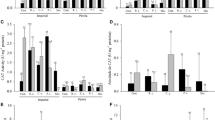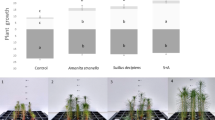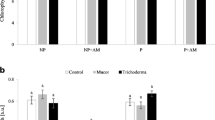Abstract
Studies on the functional significance of bacteria associated with ectomycorrhizal (ECM) fungi are scarce, as well as information on the metabolism of the host plant when in symbiosis with ECM fungi. Here we intended to evaluate the phenolic profile of seedlings when associated with Bacillus subtilis (B1), Pisolithus tinctorius (Pis) and their combination (PisB1). The interaction between microorganisms was conducted in three stages: (i) in vitro evaluation of fungal/bacterial interaction, (ii) microcosms, (iii) plant transplantation to natural soil. The profile of phenolic compounds was determined at the end of stages (ii) and (iii) and further supplemented with biometric, nutritional and analysis of the ectomycorrhizal community by denaturing gradient gel electrophoresis. In the in vitro compatibility test, B1 inhibited fungal growth at all glucose concentrations tested. In the microcosm, the levels of chlorogenic and p-coumaric acid decreased over time, unlike the protocatechuic acid which tended to increase during 70 days. After transplantation to the soil, the levels of phenolic acids decreased in all treatments, while catechin increased. B. subtilis positively influenced the fungus-plant relationship as was evidenced by higher biomass of seedlings inoculated with the dual inoculum (PisB1), both in the microcosm and soil stages. The presence of the bacteria interfered in the composition of the ECM fungal community installed in Pinus pinea L. in the soil. This leads to infer that B. subtilis may have caused a greater effect on the metabolism of P. pinea, especially in synergy with mycorrhizal fungi, than the action of the isolated fungus.








Similar content being viewed by others
Abbreviations
- Pis:
-
Pisolithus tinctorius
- B1:
-
Bacillus subtilis
- PisB1:
-
P. tinctorius + B.subtilis
- N:
-
Nitrogen
- P:
-
Phosphorus
- NUE:
-
Nitrogen use efficiency
- PUE:
-
Phosphorus use efficiency
- RGR:
-
Relative growth rate
- SQ:
-
Slenderness quotient
- H:
-
Height
- D:
-
Diameter
- Rt:
-
Root
- Sh:
-
Shoot
- DM:
-
Dry mass
- SDM:
-
Shoot dry mass
- RDM:
-
Root dry mass
- Cat:
-
Catechin
- Cum:
-
Coumaric acid
- Chl:
-
Chlorogenic acid
- Prot:
-
Protocatechuic acid
References
Abdel-Lateif K, Bogusz D, Hocher V (2012) The role of flavonoids in the establishment of plant roots endosymbioses with arbuscular mycorrhiza fungi, rhizobia and Frankia bacteria. Plant Signal Behav 7:636–641
Akula R, Ravishankar GA (2011) Influence of abiotic stress signals on secondary metabolites in plants. Plant Signal Behav 6:1720–1731. https://doi.org/10.4161/psb.6.11.17613
Aliferis KA, Chamoun R, Jabaji S (2015) Metabolic responses of willow (Salix purpurea L.) leaves to mycorrhization as revealed by mass spectrometry and 1H NMR spectroscopy metabolite profiling. Front Plant Sci 6:344. https://doi.org/10.3389/fpls.2015.00344
Araújo GC, Sousa NR, Ramos MA, Vega AL, Castro PML (2018) Performance of Quercus suber L. at nursery stage- application of two bio-inoculants under two distinct environments. Ann For Sci 75:29. https://doi.org/10.1007/s13595-018-0700-3
Ayres PG (ed) (1981) Effects of disease on the physiology of the growing plant. Society for experimental biology, seminar series no. 11. Cambridge University Press, Cambridge
Babalola OO (2010) Beneficial bacteria of agricultural importance. Biotechnol Lett 32:1559–1570
Barriuso J, Solano BR, Lucas JA, Lobo AP, Villaraco AG, Manero FJG (2008) Ecology, genetic diversity and screening strategies of plant growth promoting rhizobacteria (PGPR). In: Ahmad I, Pichtel J, Hayat S (eds) Plant-bacteria interactions. Wiley, New York. https://doi.org/10.1002/9783527621989.ch1
Bashan y, Kamnev AA, Bashan LE (2013) A proposal for isolating and testing phosphate solubilizing bacteria that enhance plant growth Article in biology and fertility of soils. https://doi.org/10.1007/s00374-012-0756-4
Bending GD, Aspray TJ, Whipps JM (2006) Significance of microbial interactions in the mycorrhizosphere. Adv Appl Microbiol 60:97–132
Bennett RN, Wallsgrove RM (1994) Secondary metabolites in plant defense mechanisms. New Phytol 127:617–633
Brundrett M, Bougher N, Dell B, Grove T, Malajczuk N (1996) Working with mycorrhizas in forestry and agriculture. Pirie Printers, Canberra, pp 173–216
Cairney JWG, Chambers SM (1997) Interactions between Pisolithus tinctorius and its hosts: a review of current knowledge. Mycorrhiza 7:117–131
Caretto S, Linsalata V, Colella G, Mita G, Lattanzio V (2015) Carbon fluxes between primary metabolism and phenolic pathway in plant tissues under stress. Int J Mol Sci 16(11):26378–26394. https://doi.org/10.3390/ijms161125967
Churchland C, Grayston SJ (2014) Specificity of plant-microbe interactions in the tree mycorrhizosphere biome and consequences for soil C cycling. Front Microbiol 5:261. https://doi.org/10.3389/fmicb.2014.00261
Compant S, Clément C, Sessitsch A (2010) Plant growth-promoting bacteria in the rhizo- and endosphere of plants: their role, colonization, mechanisms involved and prospects for utilization. Soil Biol Biochem 42:669–678
Cumming SG, Allen CR, Ban NC et al (2015) Understanding protected area resilience: a multi-scale, social-ecological approach. Ecol Appl 25:299–319
Devi MC, Reddy MN (2002) Phenolic acid metabolism of groundnut (Arachis hypogaea L.) plants inoculated with VAM fungus and Rhizobium. Plant Growth Regul 37:151–156
Dhawi F (2016) Mycorrhiza, bacteria and plant an organized model of rhizoshere interaction. Int J Sci Eng Res 7:61–77
Działo M, Mierziak J, Korzun U, Preisner M, Szopa J, Kulma A (2016) The potential of plant phenolics in prevention and therapy of skin disorders. Int J Mol Sci 17(2):160
Eftekhari M, Alizadeh M, Mashayekhi F, Asghari HR (2012) In vitro propagation of four Iranian grape varieties: influence of genotype and pretreatment with arbuscular mycorrhiza. Vitis 51(4):175–182
Graça JP, Ueda T, Janegitz T, Vieira S, Salvador M et al (2016) The natural plant stress elicitor cis-jasmone causes cultivar dependent reduction in growth of the stink bug, Euschistus heros and associated changes in flavonoid concentrations in soybean, Glycine max. Phytochemistry 131:84–91
Heleno SA, Martins A, Queiroz MJ, Ferreira IC (2015) Bioactivity of phenolic acids: metabolites versus parent compounds: a review. Food Chem 173:501–513. https://doi.org/10.1016/j.foodchem.2014.10.057
Ibrahim MH, Jaafar HZE, Rahmat A, Rahman ZA (2011) Effects of nitrogen fertilization on synthesis of primary and secondary metabolites in three varieties of Kacip fatimah (Labisia Pumila Blume). Int J Mol Sci 12(8):5238–5254. https://doi.org/10.3390/ijms12085238
Jefferies P, Gianinazzi S, Perotto S, Turnau K, Barea JM (2003) The contribution of arbuscular mycorrhizal fungi in sustainable maintenance of plant health and soil fertility. Biol Fertil Soils 37:1–16
Khoddami A, Meredith AW, Robers TH (2013) Techniques for analysis of plant phenolic compounds. Molecules 18:2328–2375
Koes R, Verweij W, Quattrocchio F (2005) Flavonoids: a colorful model for the regulation and evolution of biochemical pathways. Trends Plant Sci 10:236–242
Kojima M, Uritani I (1972) Studies on chlorogenic acid biosynthesis in sweet potato root tissue using transcinnamic acid-2-C and quinic acid -G-3 H. Plant Cell Physiol 13:311–319
Labbé JL, Weston DJ, Dunkirk N, Pelletier DA, Tuskan GA (2014) Newly identified helper bacteria stimulate ectomycorrhizal formation in Populus. Front Plant Sci 5:579. https://doi.org/10.3389/fpls.2014.00579
Lavania M, Chauhan PS, Chauhan SVS, Singh HB, Nautiyal CH (2006) Induction of plant defense enzymes and phenolics by treatment with plant growth- promoting rhizobacteria Serratia marcescens NBRI1213. Curr Microbiol 52:363–368
Marx DH (1969) The influence of ectotrophic mycorrhizal fungi on the resistance of pine roots to pathogenic infections. II. Production, identification, and biological activity of antibiotics produced by Leucopaxillus cerealis var. piceina. Phytopathology 59:411–417
Marx DH (1977) Tree host range and world distribution of the ectomycorrhizal fungus Pisolithus tinctorius. Can J Microbiol 23:217–223
Mechri B, Tekaya M, Cheheb H, Attia F, Hammami M (2015) Accumulation of flavonoids and phenolic compounds in olive tree roots in response to mycorrhizal colonization: a possible mechanism for regulation of defense molecules. J Plant Physiol 185:40–43
Niemi K, Julkunen-Tiitto R, Häggman H, Sarjala T (2007) Suillus variegatus causes significant changes in the content of individual polyamines and flavonoids in Scots pine seedlings during mycorrhiza formation in vitro. J Exp Bot 58:391–401
Nouri E, Breuillin-Sessoms F, Feller U, Reinhardt D (2015) Correction: phosphorus and nitrogen regulate arbuscular mycorrhizal symbiosis in Petunia hybrida. PLoS ONE 10(4):e0127472. https://doi.org/10.1371/journal.pone.0127472
Oliveira CM, Barros AS, Silva Ferreira AC, Silva AMS (2015) Influence of the temperature and oxygen exposure in red Port wine: a kinetic approach. Food Res Int 75:337–347
Ponce M, Cervino M, Erra-Balsells R, Ocampo JA, Godeas A (2004) Flavonoids from shoots and roots Trifolium repens (white clover) grow in presence or absence of the arbuscular mycorrhizal fungus Glomus intraradices. Phytochemistry 65:3131–3134
Prithiviraj B, Perry LG, Badri DV, Vivanco JM (2007) Chemical facilitation and induced pathogen resistance mediated by a root-secreted phytotoxin. New Phytol 173:852–860
Riedlinger J, Schrey SD, Tarkka MT, Hampp R, Kapur M, Fiedler HP (2006) Auxofuran, a novel metabolite that stimulates the growth of fly agaric, is produced by the mycorrhiza helper bacterium Streptomyces strain AcH 505. Appl Environ Microbiol 72:3550–3557
Sampietro DA, Vattuone MA (2006) Sugarcane straw and its phytochemicals as growth regulators of weed and crop plants. Plant Growth Regul 48:21–27
Santos EL, Silva FA, Silva FSB (2017) Arbuscular mycorrhizal fungi increase the phenolic compounds concentration in the bark of the stem of Libidibia ferrea in field conditions. Open Microbiol J 11:283–291. https://doi.org/10.2174/1874285801711010283
Scagel CF, Lee J (2012) Phenolic composition of basil plants is differentially altered by plant nutrient status and inoculation with mycorrhizal fungi. HortScience 47:660–671
Schrey SD, Erkenbrack E, Früh E et al (2012) Production of fungal and bacterial growth modulating secondary metabolites is widespread among mycorrhiza-associated streptomycetes. BMC Microbiol 12:164
Schweiger R, Baier MC, Persicke M, Müller C (2014) High specificity in plant leaf metabolic responses to arbuscular mycorrhiza. Nat Commun. https://doi.org/10.1038/ncomms4886
Shishido M, Massicotte HB, Chanway CP (1996) Effect of plant growth promoting Bacillus strains on pine and spruce seedlings growth and mycorrhizal infection. Ann Bot 77:433–441
Siddiqi MY, Glass ADM (1981) Utilization index: a modified approach to the estimation and comparison of nutrient utilization efficiency in plants. J Plant Nutr 4:289–302
Singla P, Garg N (2017) Plant flavonoids: key players in signaling, establishment, and regulation of rhizobial and mycorrhizal endosymbioses. Mycorrhiza-Function, Diversity, State of the Art, 133–176
Sousa NR, Franco AR, Ramos MA, Oliveira RS, Castro PML (2015) The response of Betula pubescens to inoculation with an ectomycorrhizal fungus and a plant growth promoting bacterium is substrate-dependent. Ecol Eng 81:439–443
Sutela S, Niemi K, Edesi J, Laakso T, Saranpää P et al (2009) Phenolic compounds in ectomycorrhizal interaction of lignin modified silver birch. BMC Plant Biol 9:124
Tarkka MT, Frey-Klett P (2008) Mycorrhiza helper bacteria. In Varma A (ed) Mycorrhiza. Springer, Berlin, 113–132
Thompson BE (1985) Seedling morphological evaluation: what you can tell by looking. In: Duryea ML (ed) Evaluating seedling quality: principles, procedures, and predictive ability of major tests. Oregon State University, Corvallis, pp 59–71
Toussaint JP, Smith FA, Smith SE (2007) Arbuscular mycorrhizal fungi can induce the production of phytochemicals in sweet basil irrespective of phosphorus nutrition. Mycorrhiza 17:291–297
Turner MF, Heuberger AL, Kirkwood JS, Collins CC, Wolfrum EJ, Broeckling CD et al (2016) Non-targeted metabolomics in diverse sorghum breeding lines indicates primary and secondary metabolite profiles are associated with plant biomass accumulation and photosynthesis. Front Plant Sci 7:953
Verma M, Brar SK, Tyagi RD, Surampalli RY, Valéro JR (2007) Antagonistic fungi, Trichoderma spp.: panoply of biological control. Biochem Eng J 37:1–20. https://doi.org/10.1016/j.bej.2007.05.012
Winger A, Purdy S, Maclean A, Pourtau N (2006) The role of sugars in integrating environmental signals during the regulation of leaf senescence. New Phytol 161:781–789
Zheng W, Wang SY (2001) Antioxidant activity and phenolic compounds in selected herbs. J Agric Food Chem 49(11):5165–5170
Acknowledgements
Giovania Araujo is grateful for the scholarship supported by CAPES-Brazilian Federal Agency for Support of the Ministry of Education of Brazil. The authors also acknowledge Fundação para a Ciência e a Tecnologia and Fundo Social Europeu (III Quadro Comunitário de Apoio) for the research grant of Nadine R. Sousa (SFRH/BPD/89112/2012). This work was supported by the project “Biological tools for adding and defending value in key agro-food chains (bio – n2 – value)”, nº NORTE-01-0145-FEDER-000030, funded by Fundo Europeu de Desenvolvimento Regional (FEDER), under Programa Operacional Regional do Norte - Norte2020; scientific collaboration of CBQF under the FCT, project UID/Multi/50016/2013, is also acknowledged.
Author information
Authors and Affiliations
Corresponding author
Rights and permissions
About this article
Cite this article
Araújo, G.C., Sousa, N.R. & Castro, P.M.L. The effect of fungal-bacterial interaction on the phenolic profile of Pinus pinea L.. Plant Growth Regul 86, 465–475 (2018). https://doi.org/10.1007/s10725-018-0445-x
Received:
Accepted:
Published:
Issue Date:
DOI: https://doi.org/10.1007/s10725-018-0445-x




